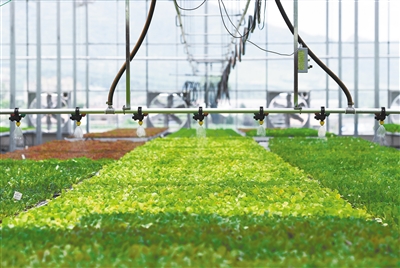
 |
| Water-saving automatic sprinklers are used to irrigate vegetables in a greenhouse in Taibai county, Shaanxi province,northwest China on June 25, 2024. (PHOTO: XINHUA) |
In the latest move to build a water-saving society, China's National Development and Reform Commission, Ministry of Water Resources, and other departments recently issued a guideline on accelerating the development of the water-conservation industry.
The guideline sets a target for the industry to reach a trillion RMB value by 2027, nurturing a group of specialized and innovative "little giant" enterprises. The plan envisages establishing a development pattern of the water-conservation industry that is primarily enterprise-driven, market-oriented, innovation-powered, and emphasizes the integration of production, education, research and application.
By 2035, the goal is to cultivate some leading enterprises, with water-saving technologies, processes, equipment manufacturing, and management services that reach advanced global standards. This will foster an all-round adoption of water-saving production and lifestyles.
To advance the upgrade and replacement of water-saving products and equipment, the guideline supports enterprises to intensify R&D, design, and production efforts. This involves constructing a supply system of water-saving products and equipment, ranging from basic raw materials to end-consumer goods, to drive the digital, intelligent and green development of water-saving products and equipment manufacturing.
Innovating water-saving management service models involves implementing intelligent water usage control in high water-consuming enterprises, industrial parks, and medium-to-large irrigation districts.
It also emphasizes strengthening digital empowerment by integrating technologies such as the Internet of Things, AI and digital twinning with the water system management techniques, to explore typical "Internet + water-saving management" application scenarios for precise water control.
Regarding promoting sci-tech innovation in the water-conservation industry, the guideline supports research institutes, universities, leading enterprises and industry associations in conducting basic and applied related research and innovation.
The guideline calls for efforts to enhance the protection and utilization of intellectual property of water-saving technologies. Platforms, such as the national water-saving industry technology innovation alliance, are to be established to drive the conversion and widespread application of water-saving technologies.
Recommendations also include stimulating investments from foreign and private capital into the water-conservation industry, and encouraging research institutions and high-tech enterprises to engage in international water-related events, and carry out overseas cooperation in water-saving technology consultation, engineering construction and management services, to support the high-quality development of the Belt and Road Initiative.


 Next
Next




